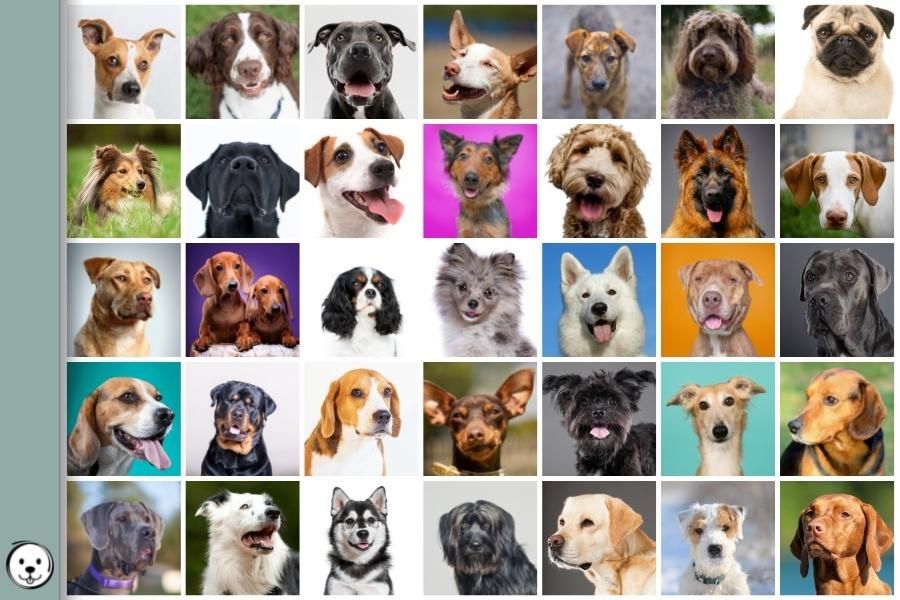This page is a quick reference to show you the possible alleles at each locus.
Summary
A list of variants and genes affecting coat colors and patterns in dogs:
B locus
The B locus determines if a dog has black or brown eumelanin.
B: Black Eumelanin
b*: Brown Eumelanin
D locus
The D locus determines if a dog has diluted eumelanin.
D: Normal Eumelanin
d*: Diluted Eumelanin
Cocoa locus (in French Bulldogs)
The Co locus determines if a dog has dark brown eumelanin.
Co: Normal Eumelanin
co: Dark Brown Eumelanin
G Locus
The (theoretical) graying locus causes a progressive fading of eumelanin intensity.
G: Progressive Graying
g: No Graying
I Locus
Red intensity is a complex trait not governed by a single gene.
- Dogs with low phaeomelanin intensity will have white or cream pigment.
- Dogs with intermediate phaeomelanin intensity will have tan or yellow pigment.
- Dogs with high phaeomelanin intensity will have orange or red pigment.
However, some labs offer testing for certain aspects of red intensity.
I: Normal Phaeomelanin Intensity
i: Low Phaeomelanin Intensity
A locus
The A locus determines the basic distribution of pigment types. Different alleles cause distinct phenotypes, but some intermediate phenotypes may happen in heterozygous dogs.
Ay: Clear Sable
Predominantly yellow.
Ays: Shaded Sable
Predominantly yellow. Dorsal coat shows dark hair tips.
aw: Agouti
Dorsal coat banded. Ventral tan markings.
asa: Saddle
Born dark, eumelanin shrinks into a saddle or creeping tan pattern.
at: Tan Point
Dorsal coat solid eumelanic. Ventral tan markings.
a: Recessive Black
Can only express eumelanin. Solid dark coat, can have minor tan bleed-through.
K Locus
The K locus determines if a dog can produce normal phaeomelanin pigment in his A locus pattern, phaeomelanin with brindle on top, or no phaeomelanin at all.
KB: Dominant black
Can only express eumelanin. Can not express A locus pattern.
kbr: Brindle
Can express A locus pattern but with dark stripes over yellow areas.
ky: Normal pattern
Can express A locus pattern.
E Locus
The E locus determines if and where a dog can produce eumelanin.
Em: Melanistic Mask
Can express A and K locus pattern.
E: Normal Pattern
Can express A and K locus pattern.
eA: Ancient domino
Can express A and K locus pattern but with reduced eumelanin.
eG: Sighthound domino
Can express A and K locus pattern but with reduced eumelanin.
eH: Cocker domino
Can express A and K locus pattern but with reduced eumelanin.
e*: Recessive Red
Can only express phaeomelanin. Can not express A and K locus pattern.
M Locus
The M Locus can remove some of the eumelanin in random areas of a pattern. It rarely affects phaeomelanin.
Merle alleles differ in length and effect strength.
The effect of combined alleles (e.g. Ma+/Mc+) can add up and cause different phenotypes than each allele on its own. Some combinations (e.g. Mh/M) might produce the dreaded double merle phenotype.
Mh: Harlequin Merle
Can delete pigment to white, may cause tweed or minimal merle.
M: Classic Merle
Marbled coat with random areas of diluted pigment.
Ma+ and Ma: Atypical Merle
Can cause muted merle patterns with a more uniform dilution of pigment.
Mc+ and Mc: Cryptic Merle
Does not cause a merle phenotype.
m: No Merle
H Locus (in Great Danes)
The H locus acts as a merle modifier. It can delete pigment in merled areas, leaving solid pigmented patches on a white base. Harlequin is only expressed on dogs with a merle pattern.
H: Harlequin in H/h dogs.
Harlequin is embryonic lethal for homozygous dogs (H/H).
h: Non-harlequin in h/h dogs.
S Locus
The spotting locus is an incomplete dominant trait. It adds white piebald markings.
S: No white spotting in S/S dogs.
Dogs can still have white markings from other spotting traits.
sP: White spotting in dogs with S/sp or sp/sp.
Dogs can show minimal to moderate to extended white.
P Locus (in German Shepherds)
Panda spotting adds white markings.
P: Panda markings in P/p dogs.
Panda is embryonic lethal for homozygous dogs (P/P).
p: No panda spotting in p/p dogs.
Dogs can still have white markings from other spotting traits.
T Locus
The T locus adds ticking or roan patterns into white markings, it is not expressed in solid patterns. Mottles will have whichever color you would have expected in their location if it wasn’t for the white.
TR: Roan
T: Ticking
t: No Ticking
Intro
All genes come with a wild type version. This is the basic version most common in wolves. However, most genes have more than one version due to mutations. The versions of a gene are called alleles.
As a reminder, each dog has two copies of each gene (or “locus“). This results in each dog having two of the possible versions of each gene (or “alleles“).
Dogs can have two copies of the same allele (e.g. B/B), in which case they’re homozygous, or two different alleles (e.g. B/b), in which case they’re heterozygous.
When talking about dog genetics, alleles are represented by a standardized letter nomenclature.
Additionally, you may want to remember the two types of pigment: Eumelanin (black, brown, blue, lilac) and phaeomelanin (off-white, cream, tan, yellow, red).
Not every dog expresses both types of pigment in his coat. But eumelanin is still visible in a dog’s skin, nose, and eye pigment while phaeomelanin can only affect the coat.
B Locus: Black & Brown
The TYRP1 gene (Tyrosinase Related Protein 1) is also called the B locus.
The B Locus determines if a dog will produce black or brown pigment.
It does not cause a pattern, it only affects the color of eumelanin in any pattern with eumelanin.
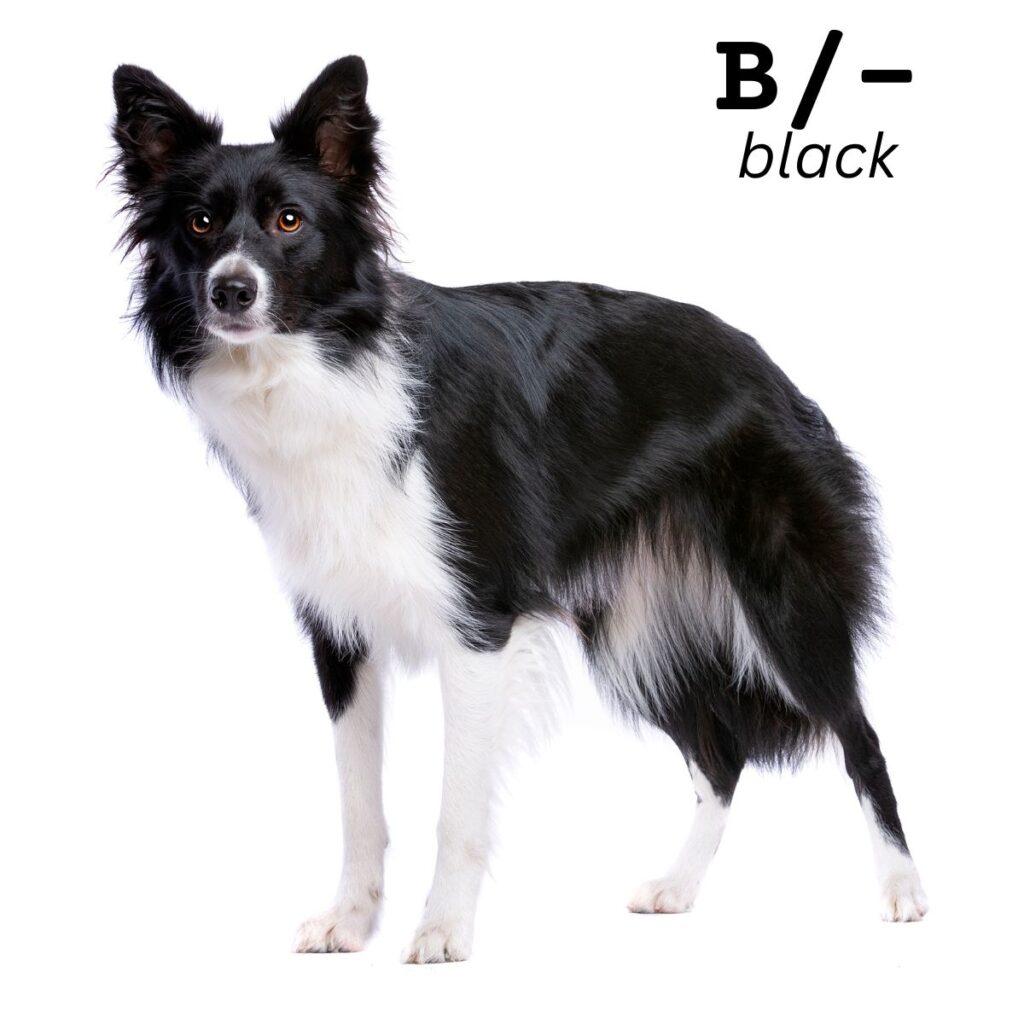

The mode of inheritance is autosomal recessive with B as the dominant wild type allele.
There are currently several known versions of b alleles (ba, bc, bd, bs, be, and bh)[1].
However, the wild type B allele is dominant over any of the recessive b alleles. Any combination of recessive b alleles will cause brown eumelanin (e.g. bd/bs).
- A dog with at least one copy of B (B/B or B/b) will have black eumelanin.
- To produce brown eumelanin, a dog must be homozygous for brown (b/b).
D Locus: Color Dilution
The MLPH gene (Melanophilin) is also called the D locus.
The D Locus determines if a dog will produce non-diluted or diluted pigment.
It does not cause a pattern, it only affects the color of eumelanin in any pattern with eumelanin.
Affected puppies will be born with diluted pigment.
Diluted black pigment (B/- d/d) is called blue in most breeds.
Diluted brown pigment (b/b d/d) is called lilac in most breeds.

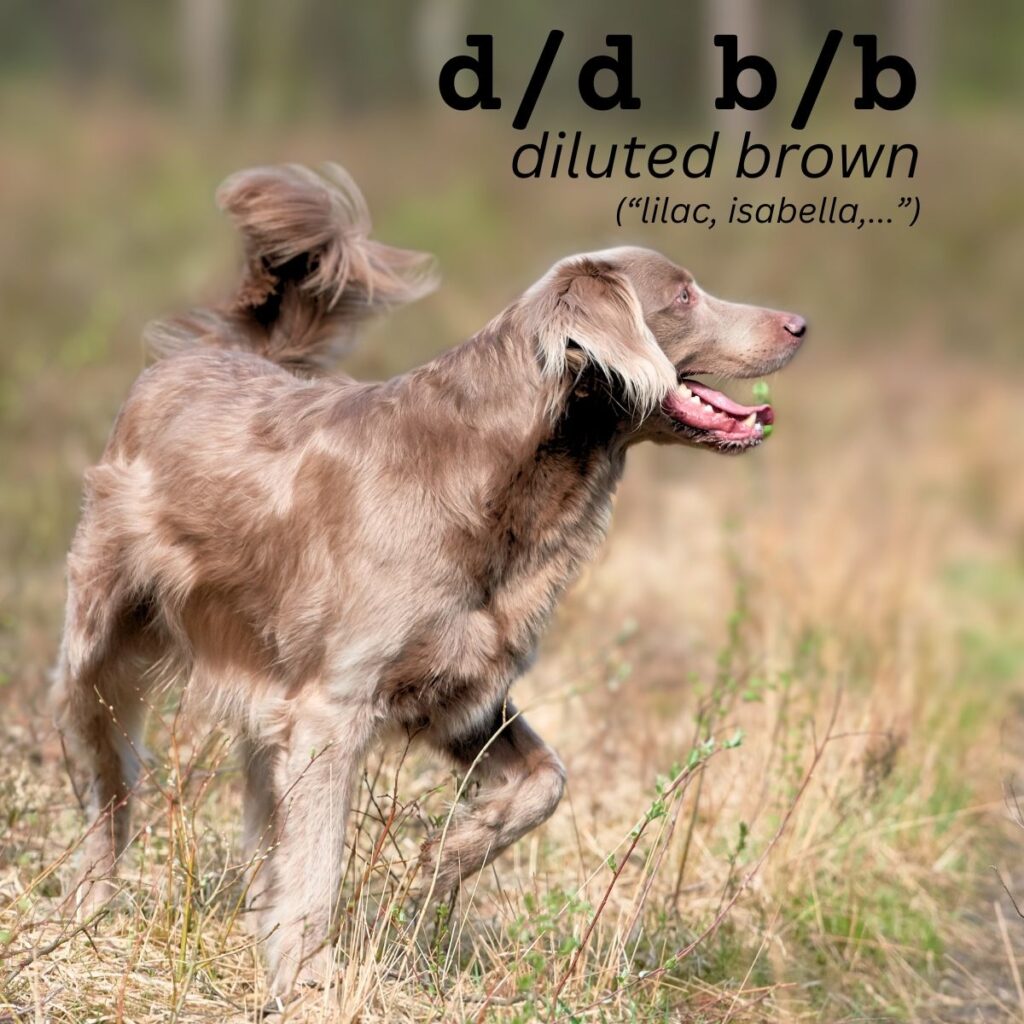
The mode of inheritance is autosomal recessive with D as the dominant wild type allele.
There are currently several known versions of d alleles (d1, d2, d3)[1].
But the wild type D allele is dominant over any of the recessive d alleles. And any possible combination of recessive d alleles will cause diluted eumelanin (e.g. d1/d3).
- A dog with at least one copy of D (D/D or D/d) will have normal eumelanin.
- A dog that is homozygous for color dilution (d/d) will express diluted eumelanin.
Co Locus (French Bulldog): Cocoa
The HPS3 gene (Hermansky-Pudlak syndrome 3) is also called the Cocoa locus.
The Co Locus determines if a dog will produce dark brown eumelanin.
It does not cause a pattern, it only affects the color of eumelanin in any pattern with eumelanin.



The mode of inheritance is autosomal recessive with Co as the dominant wild type allele.
- A dog with at least one copy of Co (Co/Co or Co/co) will have non-cocoa eumelanin.
- A dog that is homozygous for cocoa (co/co) will express dark brown eumelanin.
- Dogs can be both cocoa and brown (b/b co/co). This is called new shade.
- Diluted cocoa pigment (co/co d/d) is called lilac in Frenchies.
- Diluted brown pigment (Co/- b/b d/d) is called isabella in Frenchies.
G Locus: Progressive Graying
At the moment, the mutation causing progressive color fading is untestable.
However, there is a theoretical understanding of how this works.
First of all, this trait only seems to affect dogs with furnishings.
The G Locus determines if a dog will have fading eumelanin.
It does not cause a pattern, it only affects the color of eumelanin in any pattern with eumelanin.
Affected puppies are born with normal eumelanin pigmentation (black, brown, blue or lilac). But their eumelanin color then gradually gets lighter over time.
- Black will fade to blue or silver.
- Blue will fade to an even lighter silver gray.
- Brown will fade to silver beige or “café au lait“.
- Lilac will fade to an even lighter beige.
But there is a wide range of possible shades a dog with progressive graying can end up with.
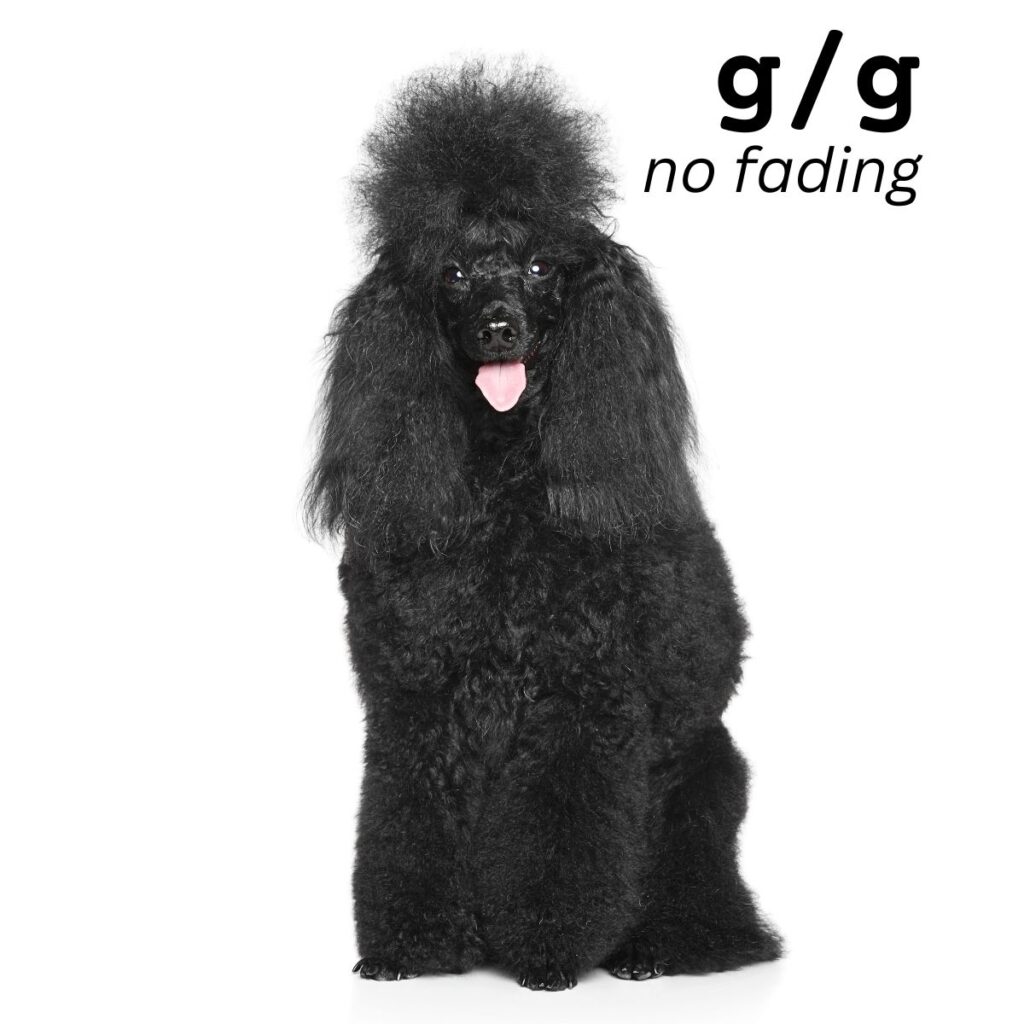

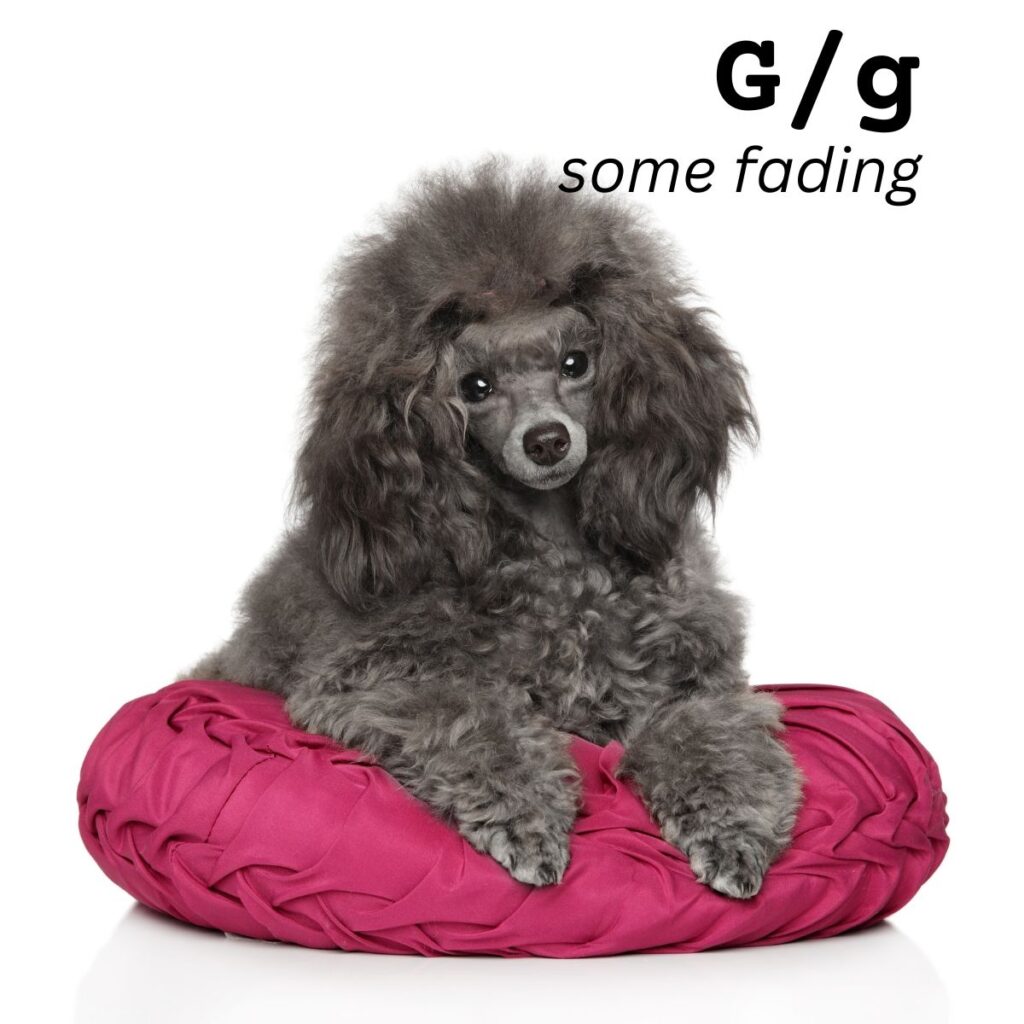

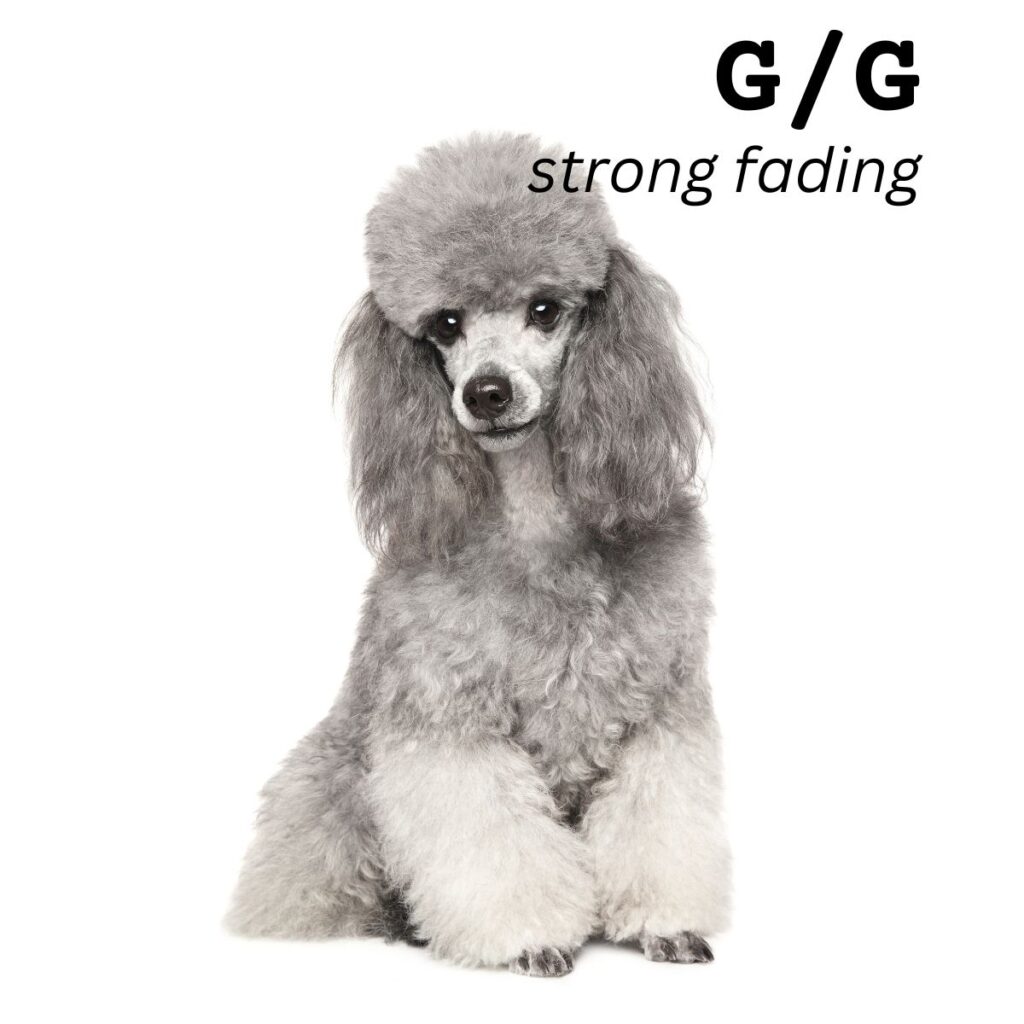

Progressive graying is an incomplete dominant trait with g as the recessive wild type allele.
The dominant graying mutation (G) causes a dose-dependent effect:
- A dog that is homozygous for graying (G/G) will express strong fading.
- A dog with at least one copy of graying (G/G or G/g) will have some fading.
- A dog that is homozygous for non-graying (g/g) will express no fading.
I Locus: Red Intensity
Phaeomelanin color intensity is not controlled by a single “Intensity locus”.
The color intensity of phaeomelanin is a complex multigenetic trait that seems to be controlled by a number of genes and modifiers. Most of these genes responsible for the final shade of phaeomelanin on a dog are still unknown and not testable at the moment.
Some labs provide testing for red intensity anyway. These tests intend to predict (more or less accurately) whether dogs will have pale or rich phaeomelanin.
Red intensity does not cause a pattern, it only affects the color of phaeomelanin in any pattern with phaeomelanin. Here it causes a wide range of colors from white to yellow to red.
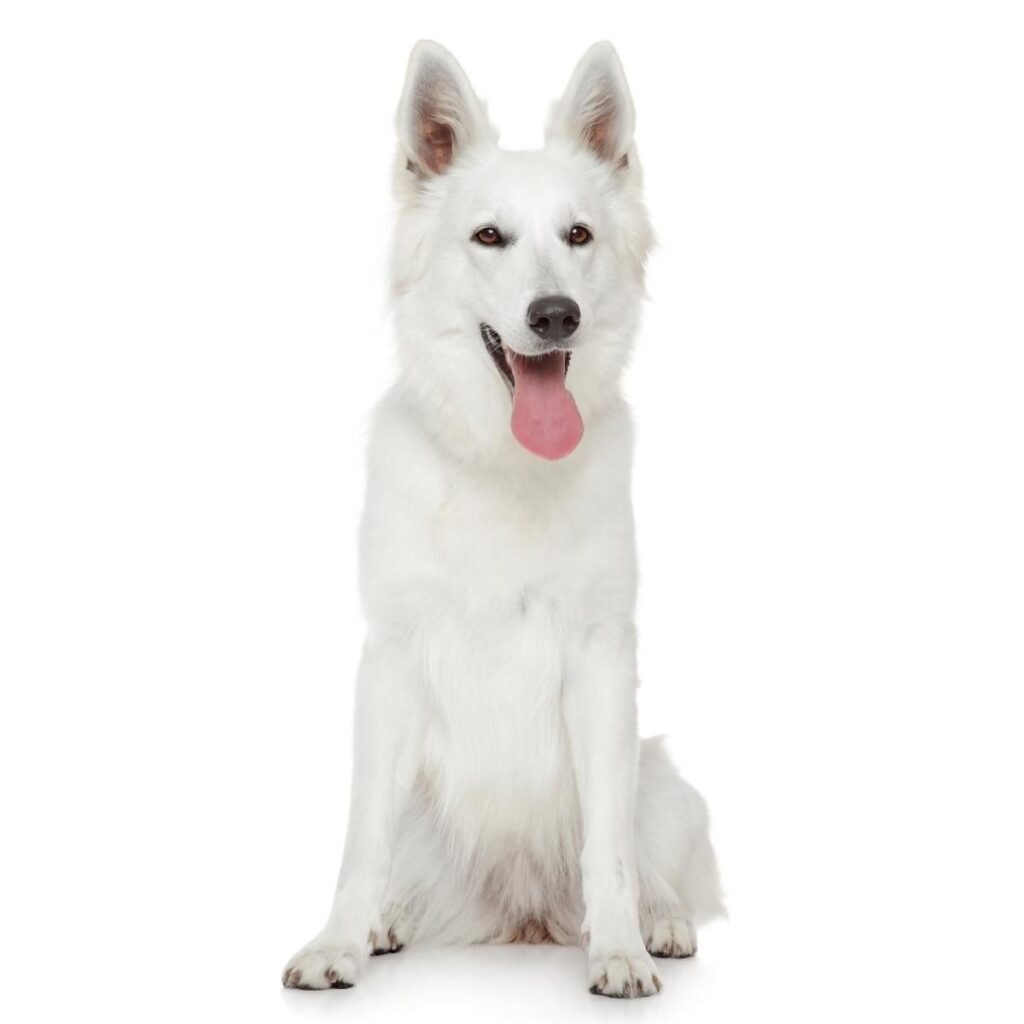
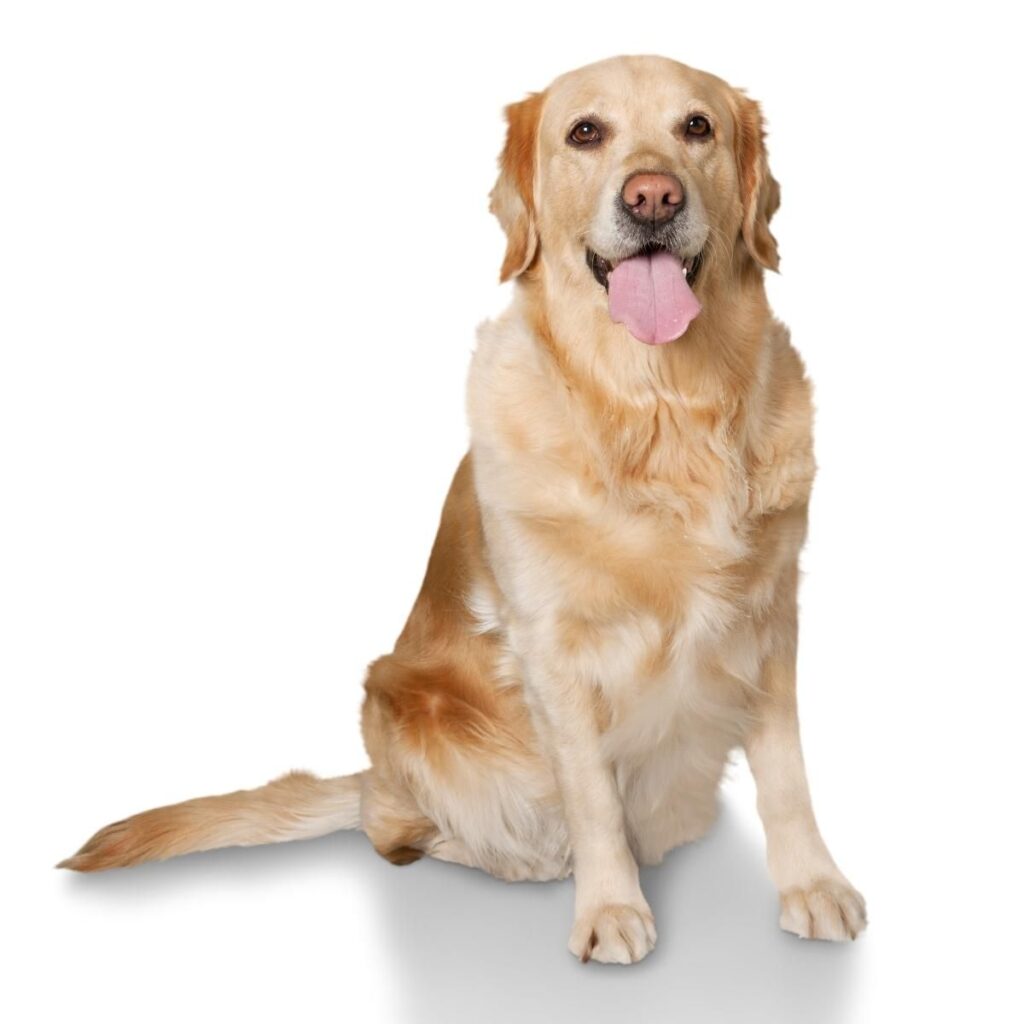
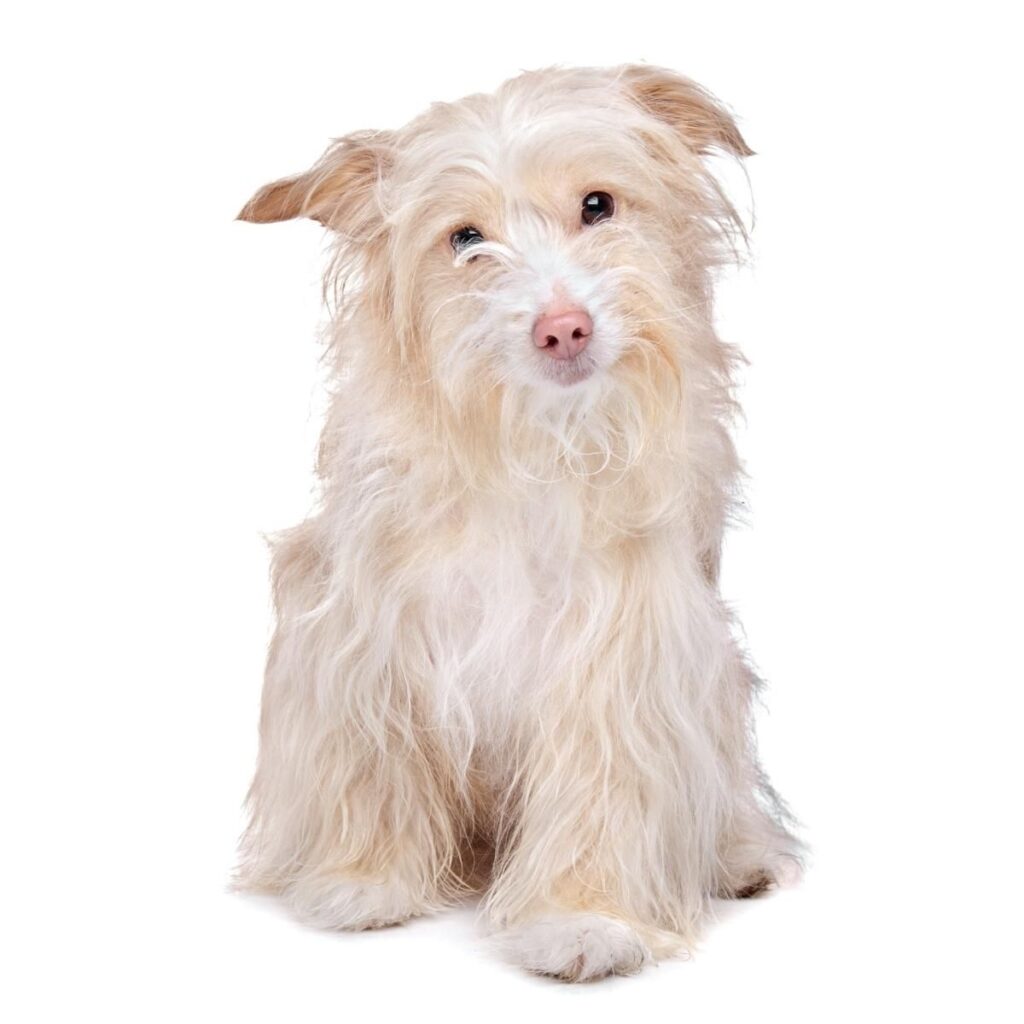
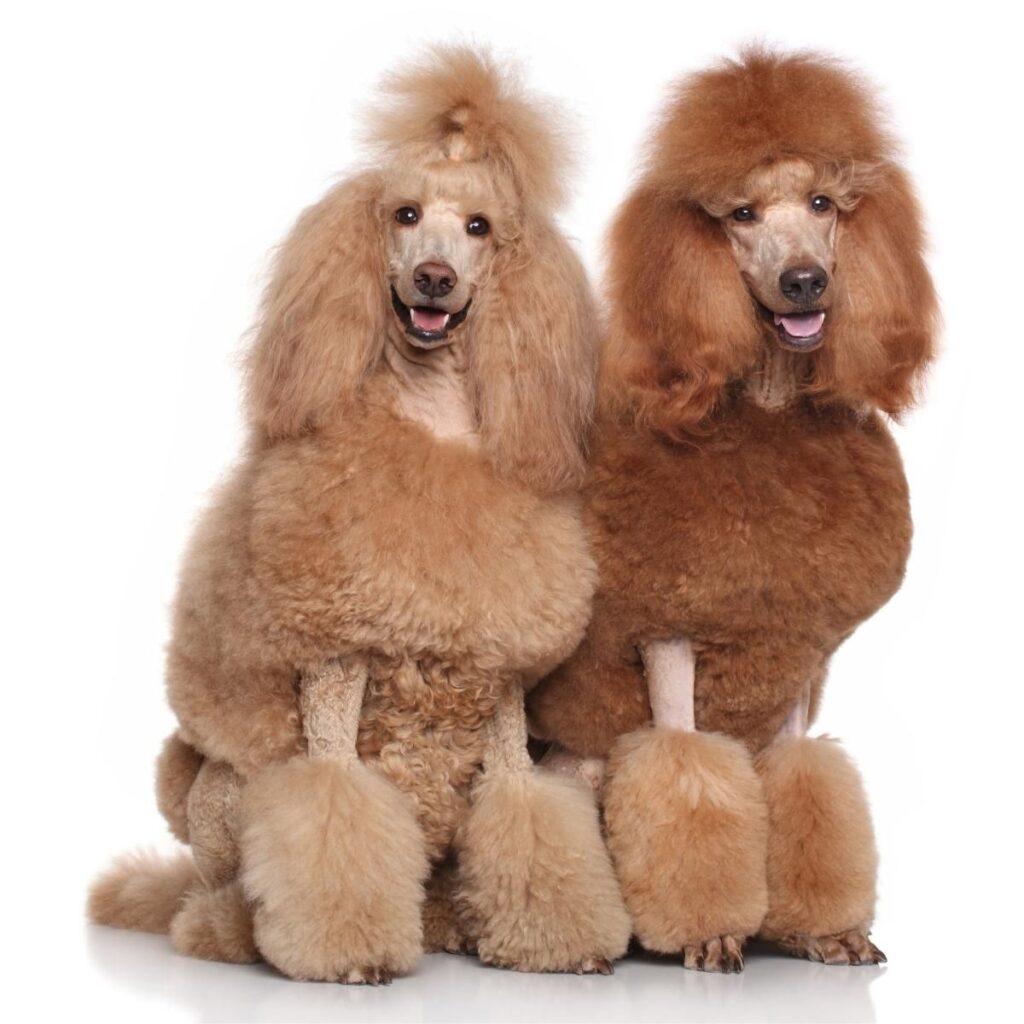

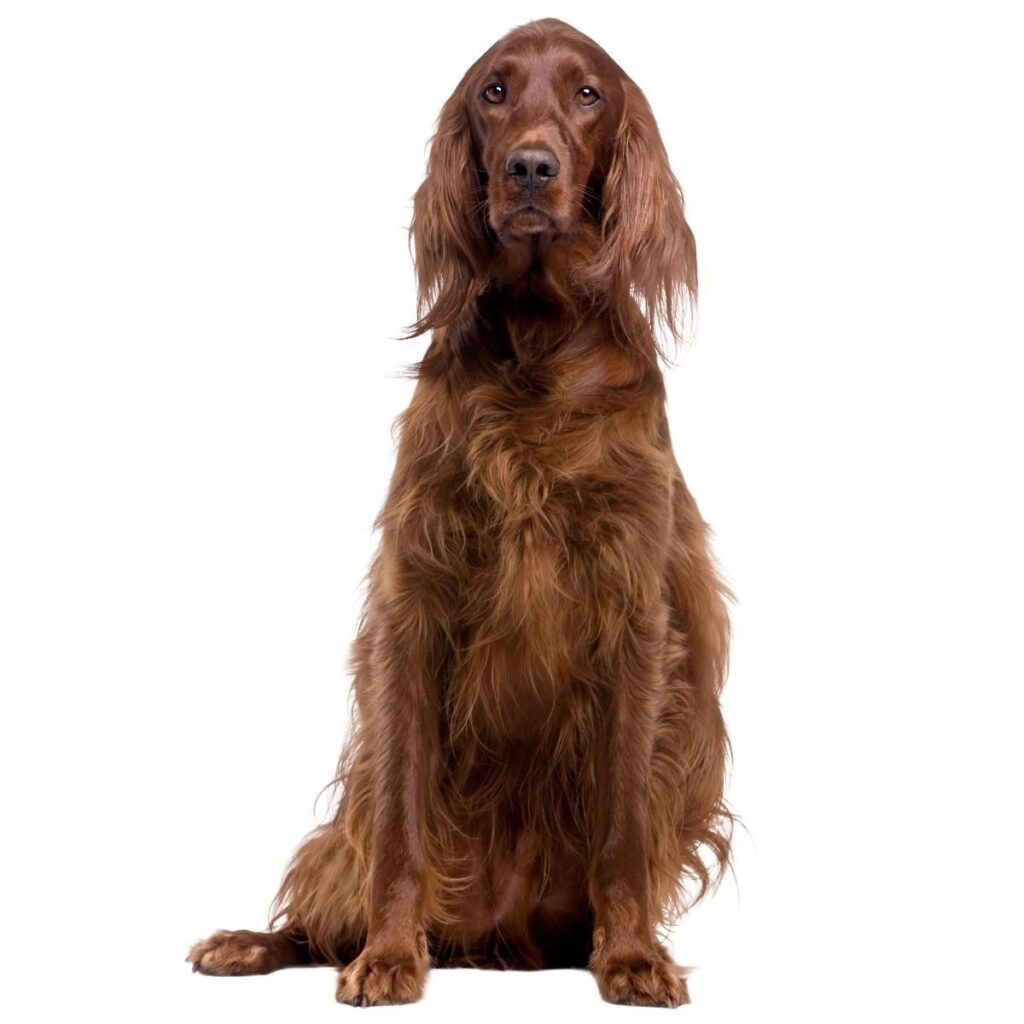
Due to the complexity of factors that control red intensity, tests can not confidently predict or guarantee which phaeomelanin colors to expect in a litter.
In general, low pigment intensity (i) is thought to be a recessive trait.
They just make an educated guess about your dog’s red intensity.
- Dogs with low phaeomelanin intensity will have white or cream pigment.
- Dogs with intermediate phaeomelanin intensity will have tan or yellow pigment.
- Dogs with high phaeomelanin intensity will have orange or red pigment.
A Locus: Pigment Patterns
The ASIP gene (Agouti Signaling Protein) is also called the A locus.
The A Locus determines what kind of pattern a dog can produce from both phaeomelanin and eumelanin.
These patterns range from all yellow to all black. And any pattern in between that contains both types of pigment. Patterns with yellow pigment can have countershading.
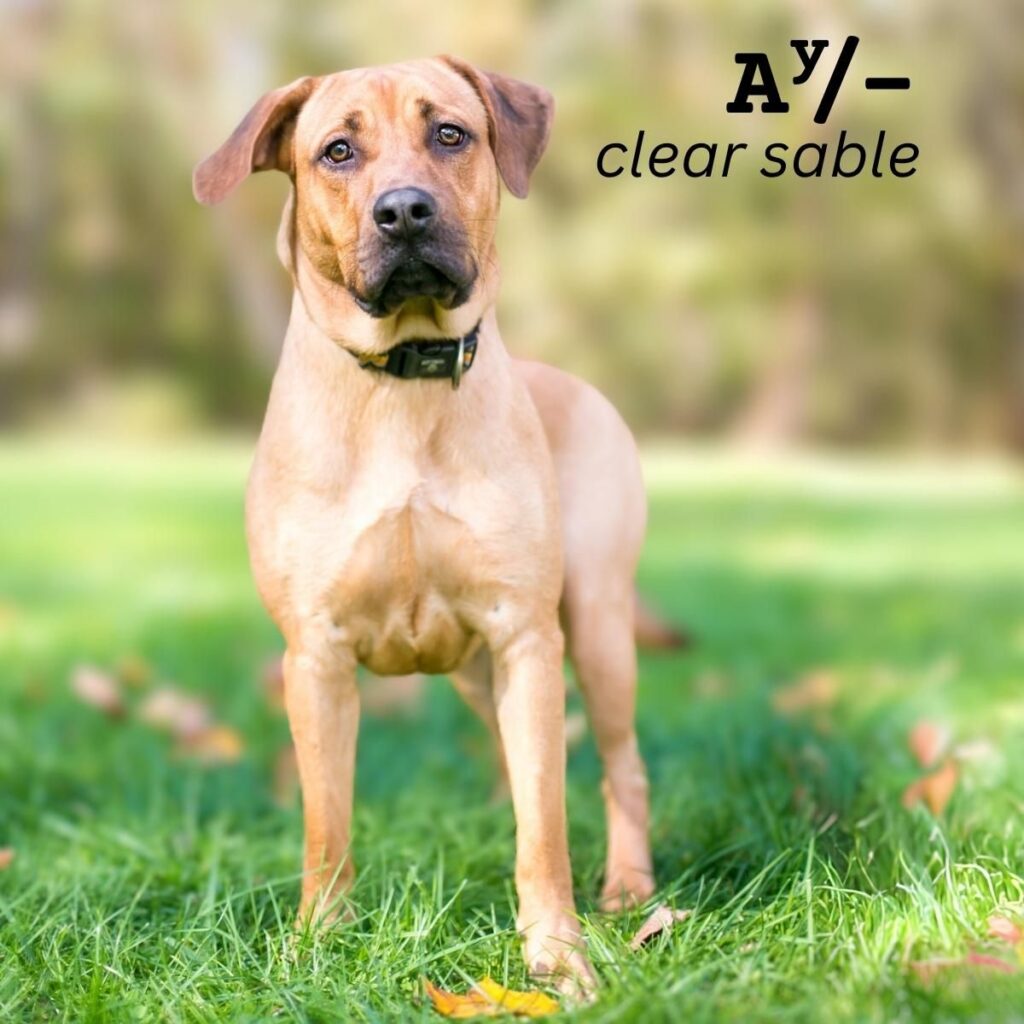


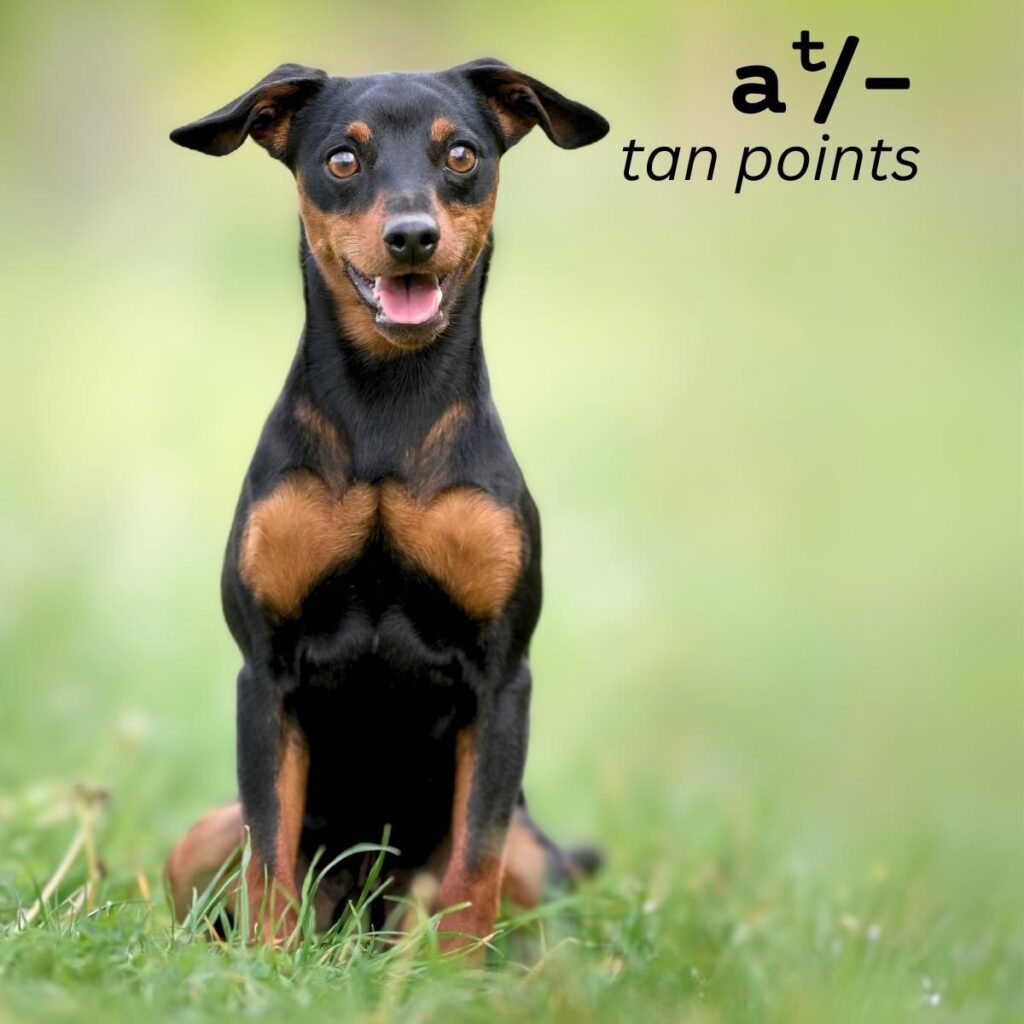
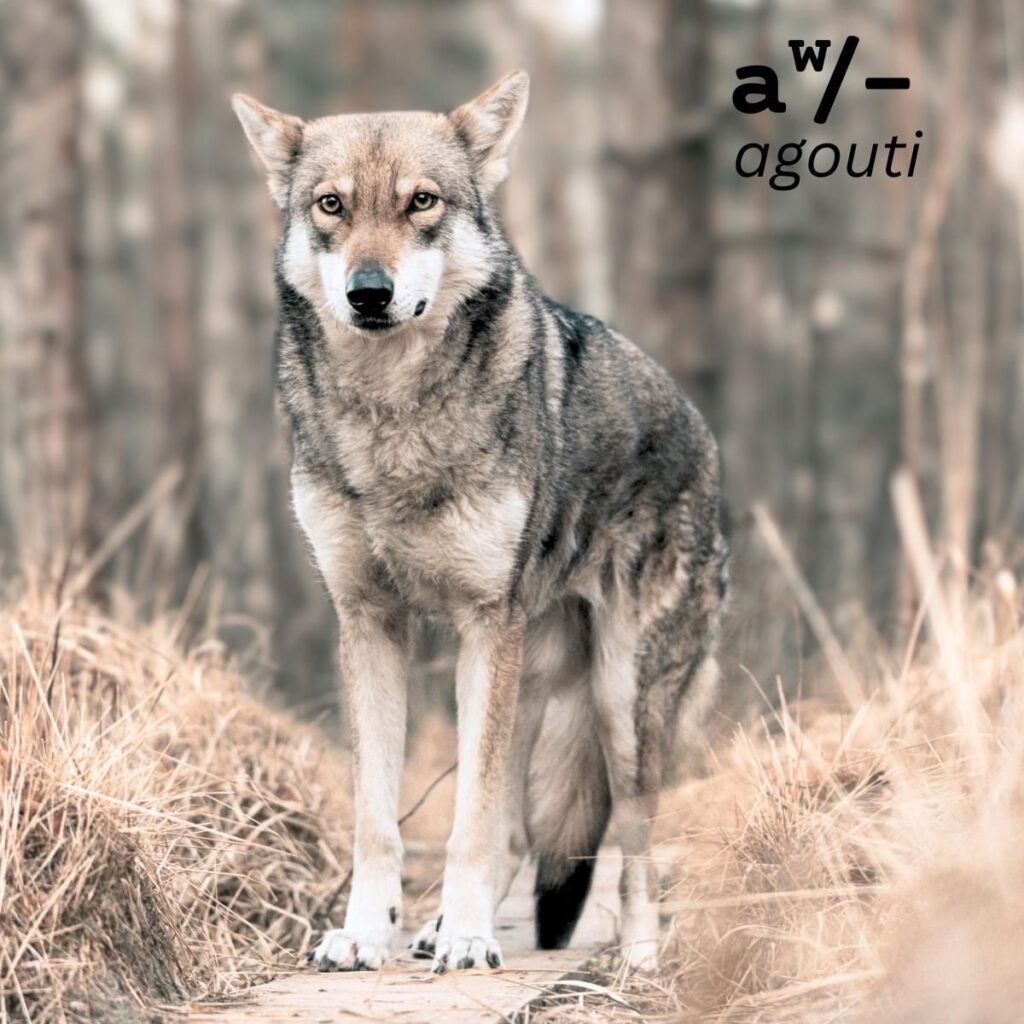
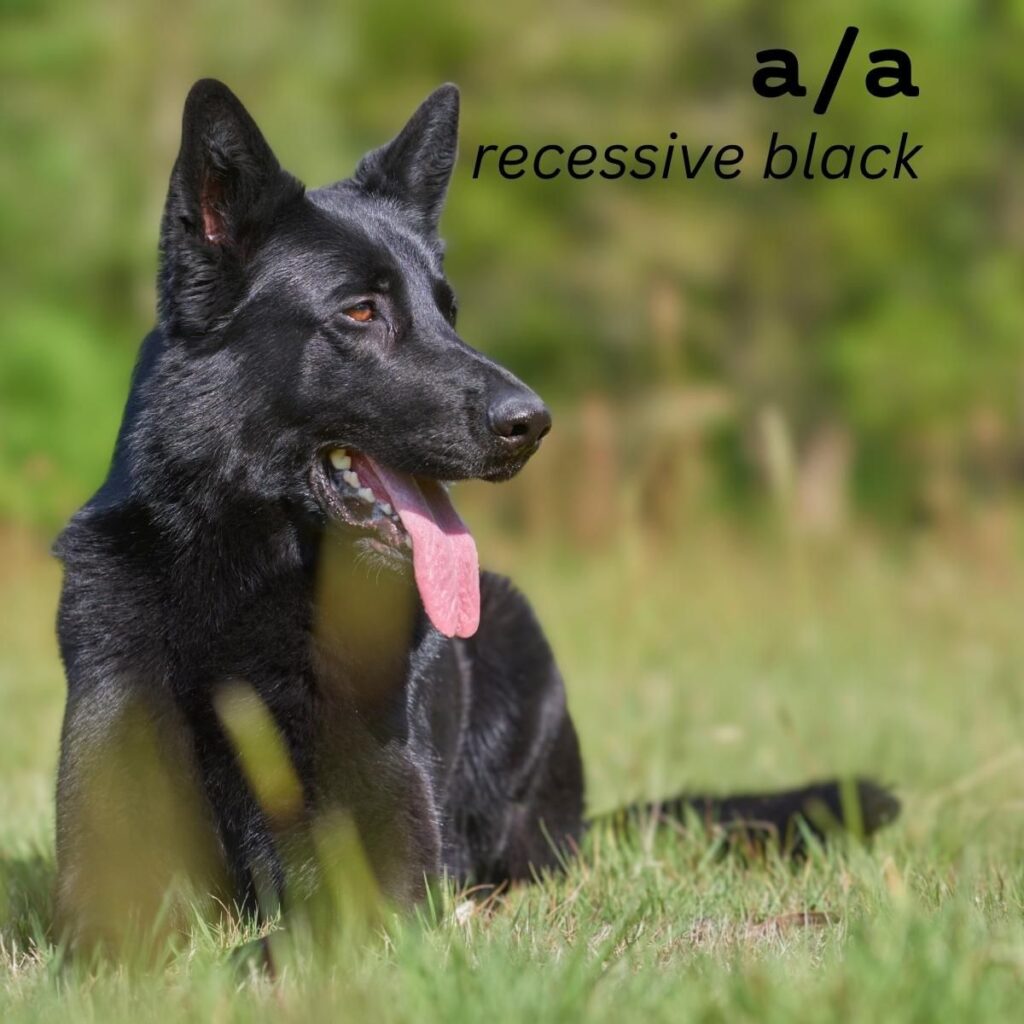
ASIP boosts phaeomelanin production.
As a rule of thumb, patterns with more phaeomelanin overrule patterns with less phaeomelanin.
The A locus creates some distinct testable patterns:
- Clear Sable (Ay/-) – dominant yellow, little to no shading
- Shaded Sable (Ays/-) – shaded yellow, lots of black hair tips along the upper half of the dog
- Agouti (aw/-)- hairs along the upper half of the dog have yellow and black bands, tan markings
- Saddle Pattern (asa/-) – born with tan points, but black shrinks into a saddle on the dog’s back
- Tan Points (at/-) – hairs along the upper half of the dog are black, tan markings*
- Recessive Black (a/-) – solid black, may have some faint yellow on the lower body
But A locus patterns are an incomplete dominant trait.
Many allele combinations cause intermediate phenotypes. As a rule of thumb, dogs carrying darker patterns will have darker coats than expected from their dominant allele.
Some examples?
- A clear sable carrying tan points or recessive black (Ay/at or Ay/a) might have black shading.
- An agouti carrying tan points (aw/at) or recessive black (aw/a) might look especially darkish.
- A saddle pattern carrying tan points (asa/at) might just have creeping tan instead of a saddle.
The list goes on.
K Locus: Black, Brindle & Patterned
The CBD103 gene (Beta-Defensin 103) is also called the K locus.
The K Locus controls if a dog can produce yellow pigment.
Remember, every dog has an A locus pattern (such as sable or tan points) in its genotype.
But the K locus determines if a dog will have either no yellow pigment at all (dominant black), or yellow pigment with black stripes (brindle), or it has no effect on yellow coat (normal pattern).
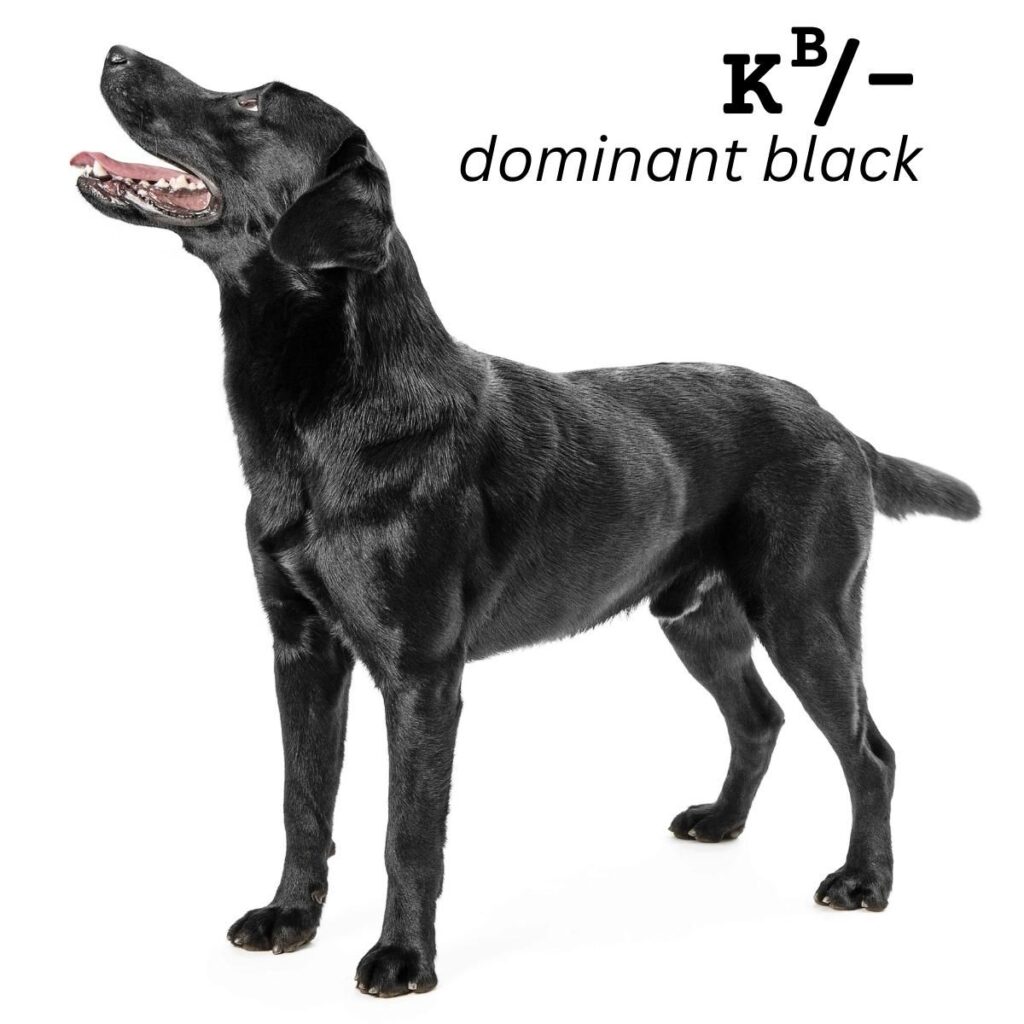


There are three alleles, dominant black KB, brindle kbr with ky as the recessive wild type
There is a clear order of dominance.
- A dog with KB/- can only produce eumelanin, no phaeomelanin. This covers up any yellow markings and causes a dominant black phenotype. Some of these dogs might express a seal phenotype.
- A dog with kbr/- can produce yellow phaeomelanin markings but will add a layer of vertical eumelanin striping. This causes a brindle phenotype.
- Only dogs with ky/ky can produce a pattern with its normal yellow phaeomelanin markings.
Keep in mind, kbr is not testable for now and will show up as KB/ky in testing results.
E Locus: Yellow, Domino & Masks
The MC1R gene (Melanocortin 1 Receptor) is also called the E locus.
The E Locus limits if and how much black pigment a dog can produce.
Again, every dog has an A locus pattern (such as sable or tan points) in its genotype. Depending on the K locus, this pattern might be covered fully (dominant black KB) or partially (brindle kbr) by eumelanin.
But the E locus can overrule the A and K locus.
It can either completely prevent eumelanin production (recessive red), restrict eumelanin production (domino), not affect the pattern but add some eumelanin to the muzzle (melanistic mask) or have no effect at all (normal pattern).

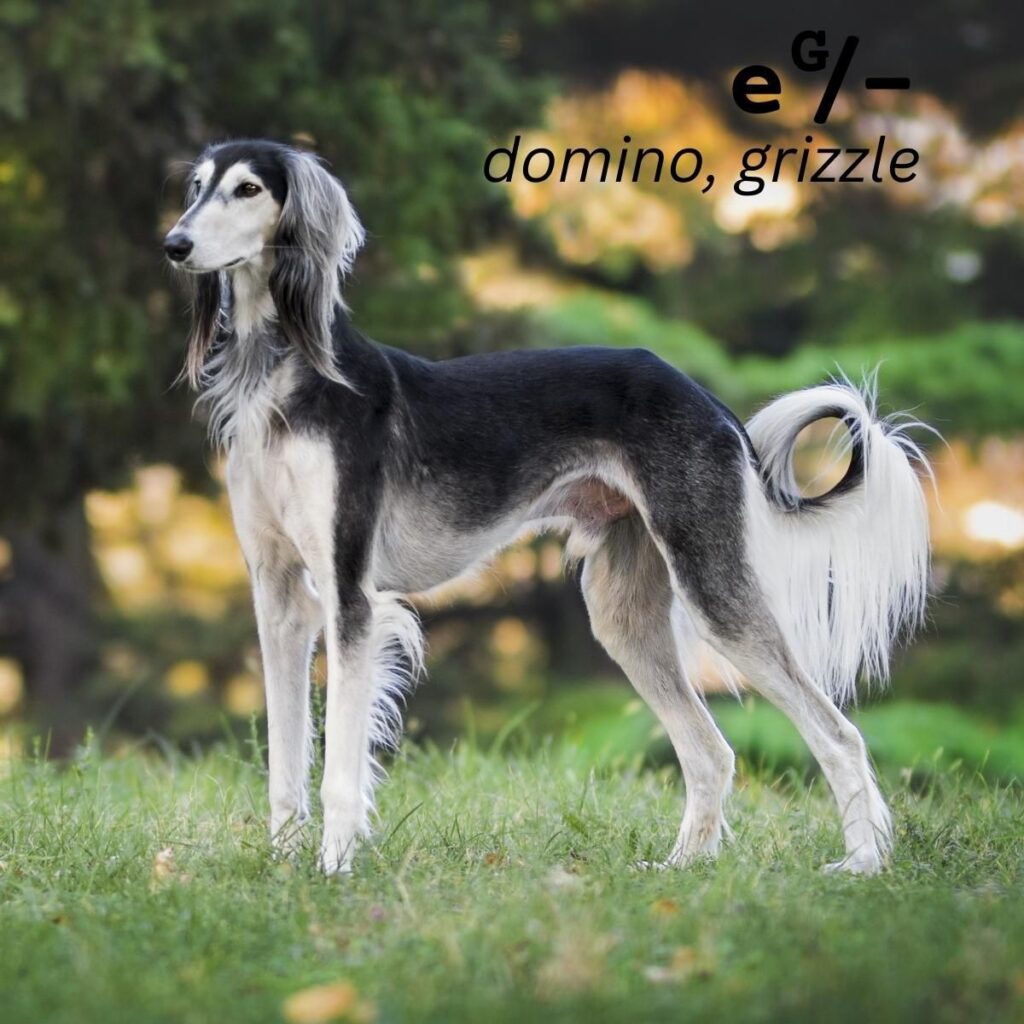
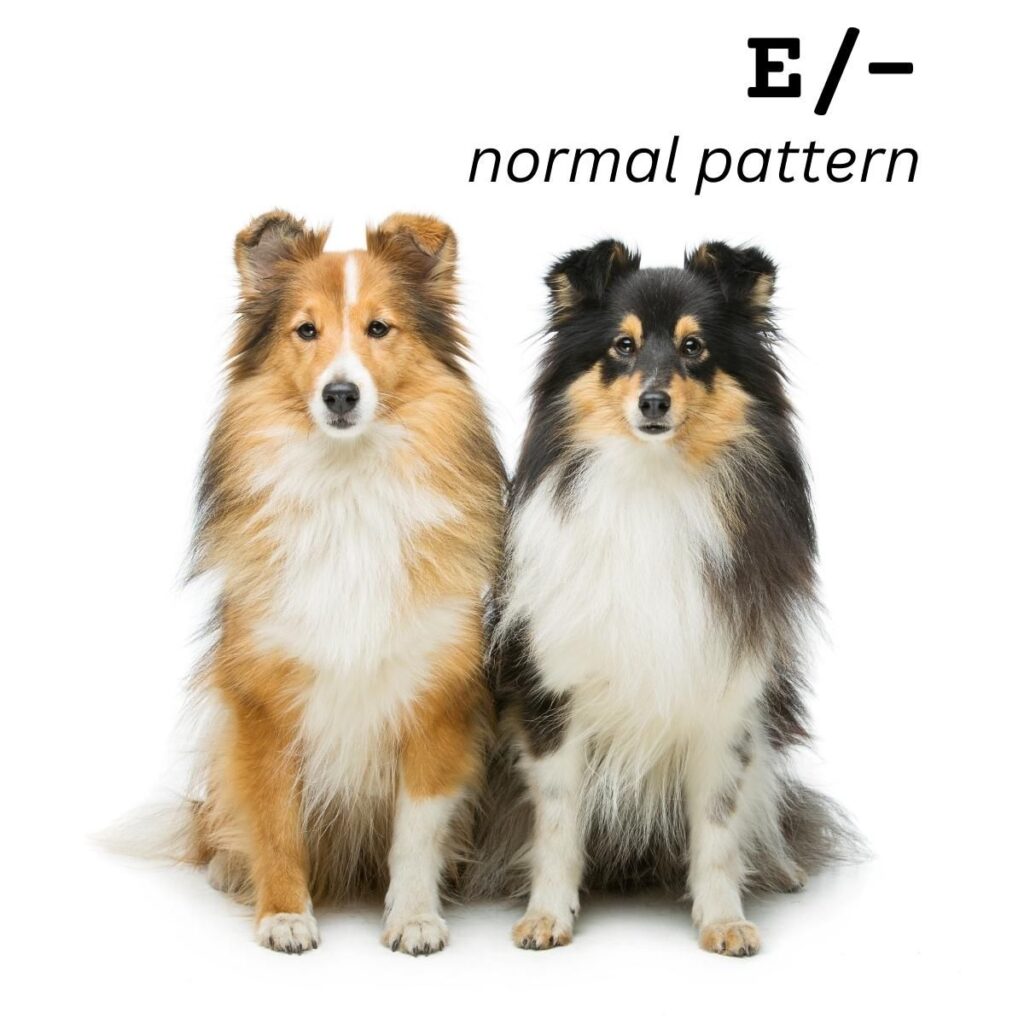

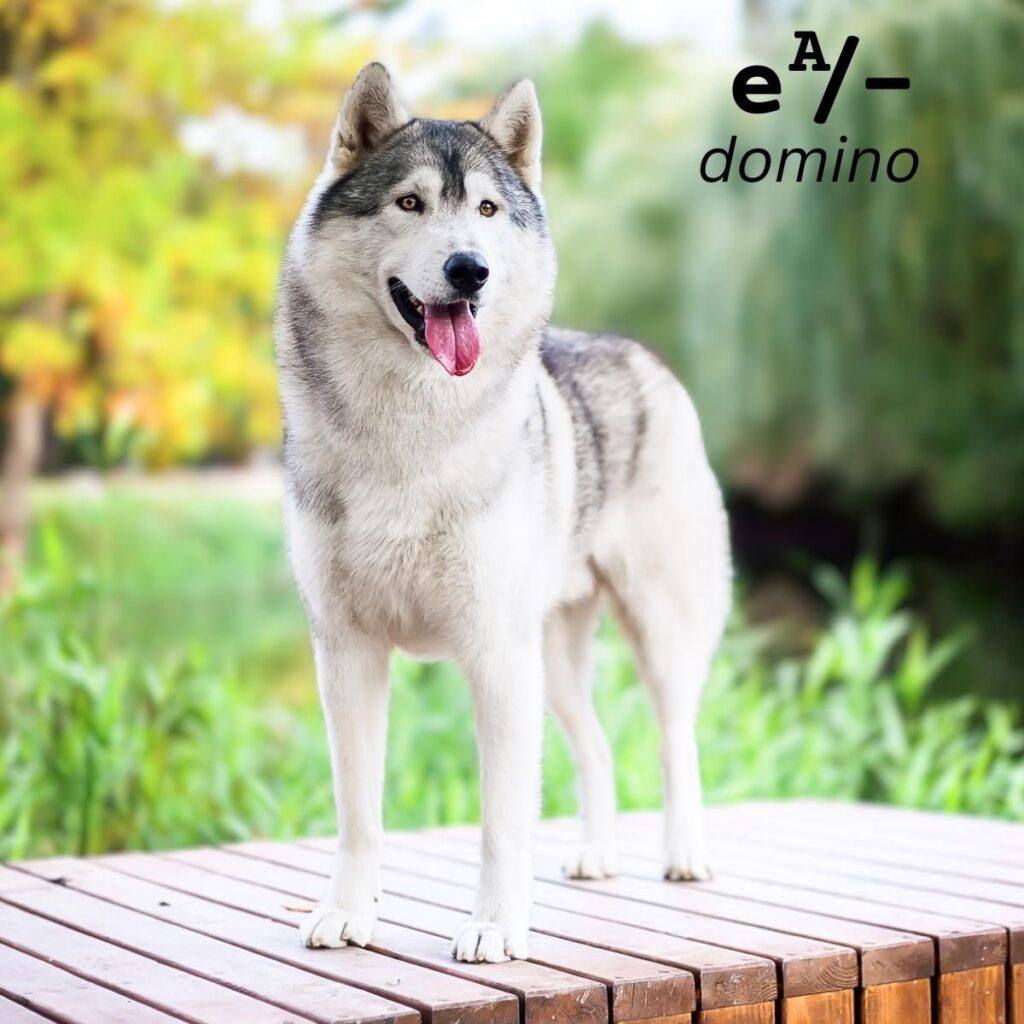

There are several known variants, namely masks (Em), domino (eA, eG, eh), and recessive red (e1, e2, e3) with E as the wild type allele that has no effect on eumelanin production.
This is the dominance hierarchy of the allelic series:
- A dog with at least one copy of Em is likely to have a dark mask.
- A dog with E/- can produce whatever pattern his K and A locus hold.
- A dog with eA/- will express ancient domino, a pattern with restricted eumelanin production.
- A dog with eG/- will express sighthound domino, a pattern with restricted eumelanin production.
- A dog with eh/- will express cocker sable, a pattern with restricted eumelanin production.
- Finally, dogs with e/e can not produce eumelanin whatsoever. They can only express phaeomelanin in their coat which causes a recessive red phenotype.
M Locus: Merle
A testable SINE insertion in the PMEL gene (premelanosome protein) is also called the M locus.
The M Locus can remove eumelanin in random areas of a pattern. It rarely affects phaeomelanin.
Depending on the length of the SINE insertion on each chromosome, merle causes some distinct patterns such as typical merle to patchwork or tweed patterns to muddy or atypical merle.


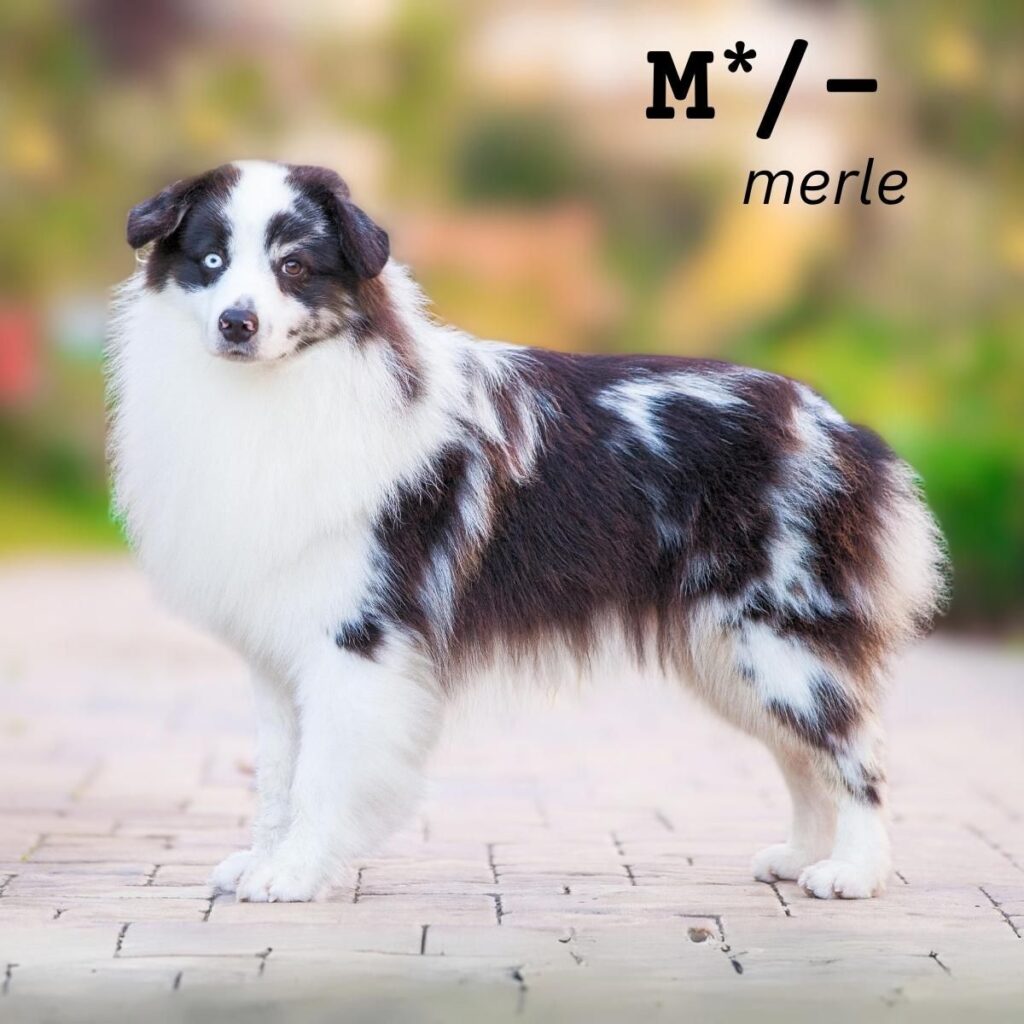
Merle has an incomplete dominant mode of inheritance and causes a dose-dependent effect.
As a rule of thumb, the longer the merle allele, the stronger the effect.
- Mh or harlequin merle has an all-or-nothing attitude. It can delete pigment to white, cause large tweedy patches with diluted pigment intensity, or cause minimal merle patterns with almost no merling.
- M or classic merle causes a typical marbled merle phenotype.
- Ma+ or atypical merle+ can cause a muted pattern with small dots on a pale background.
- Ma or atypical merle can cause a uniform gray or beige coat that resembles color dilution.
- Mc+ or cryptic merle+ does not cause a merle pattern. But it might amplify other alleles.
- Mc or cryptic merle does not cause a merle pattern.
- m is the non-merle wild type allele.
The effect of two merle alleles a dog might have can add up and produce a whole range of different phenotypes, depending on which alleles are combined (e.g. tweed patterns in Mc+/Ma+ dogs).
Unfortunately, combinations of two strong alleles (such as Mh/Ma) can delete pigment to white. This can lead to a double merle phenotype in some of the dogs that test as homozygous merle (M*/M*).
But keep in mind, having two merle alleles does not always cause double merle!
Merle is also notorious for causing mosaic phenotypes.
What happens, is the merle allele shortening during early development so that different parts of the skin may end up with different merle variants (which then might produce different patterns).
For example, a puppy might inherit m from one parent and M from its other parent and is expected to be M/m. However, when the M spontaneously shortens to Mc during early development, then the dog ends up with some cells that are M/m and some cells that are Mc/m. And when its non-expressing Mc/m cells somehow become the more frequent type of cells, you might get a minimal merle pattern.
H Locus: Harlequin Pattern in Great Danes
The PSMB7 gene (Proteasome subunit beta type-7) is also called the H locus.
The H Locus is a merle modifier exclusive to Great Danes.
Harlequin deletes pigment in areas affected by merle to white and can also affect phaeomelanin.
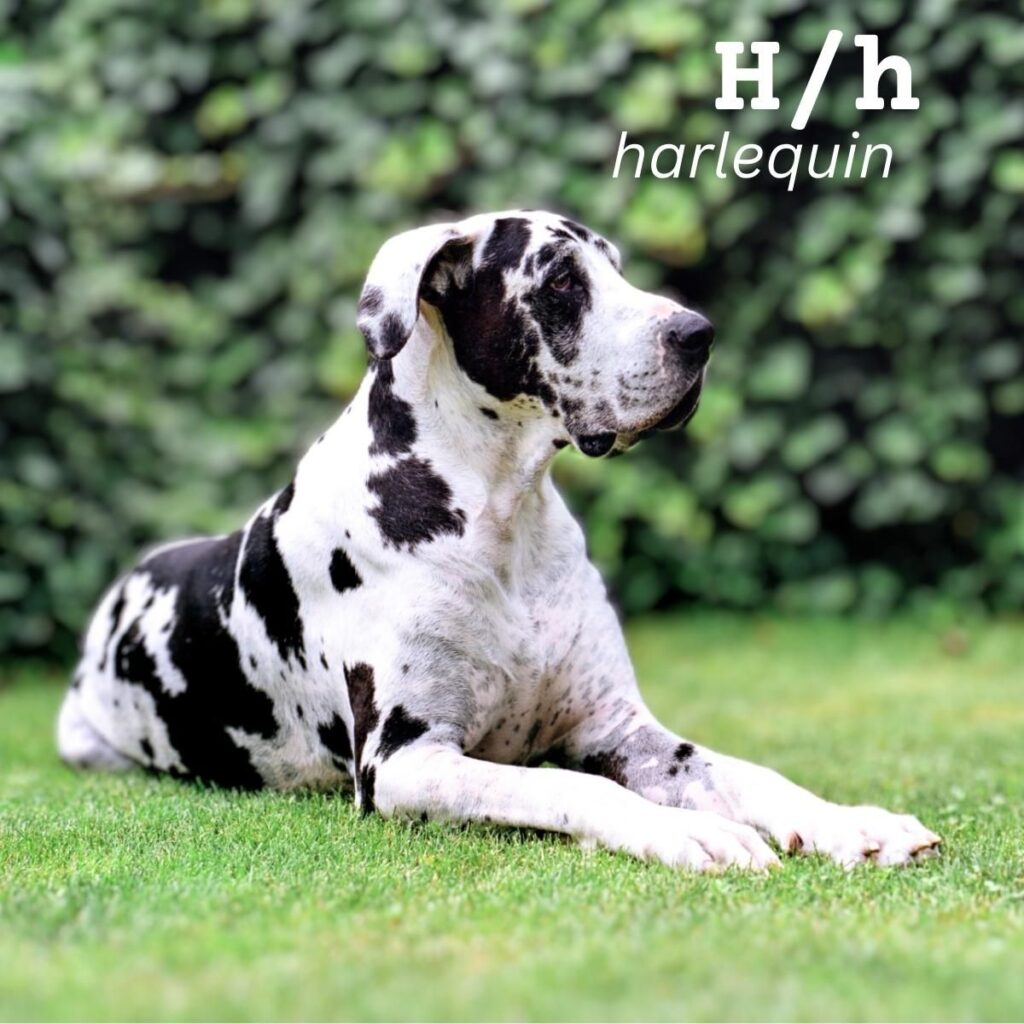
The mode of inheritance is autosomal dominant with h as the recessive wild type allele.
- Harlequin is early embryonic lethal in dogs with two copies (H/H).
- To express the harlequin pattern, a dog has to be heterozygous for harlequin (H/h) and have a merle pattern (M*/_). Dogs without merle (H/h m/m) can still pass on harlequin (H) to their merled offspring.
- Dogs that are homozygous for the wild type (h/h) don’t have a harlequin pattern.
However, the wild type B allele is dominant over any of the recessive b alleles. And any combination of recessive b alleles will cause brown eumelanin (e.g. bd/bs).
S Locus: Piebald Spotting
The MITF gene (Microphthalmia-Associated Transcription Factor) is also called the S locus.
The S Locus can cause areas that don’t have functional pigment cells.
This results in a white spotting pattern, with the white covering areas of the pattern a dog has.

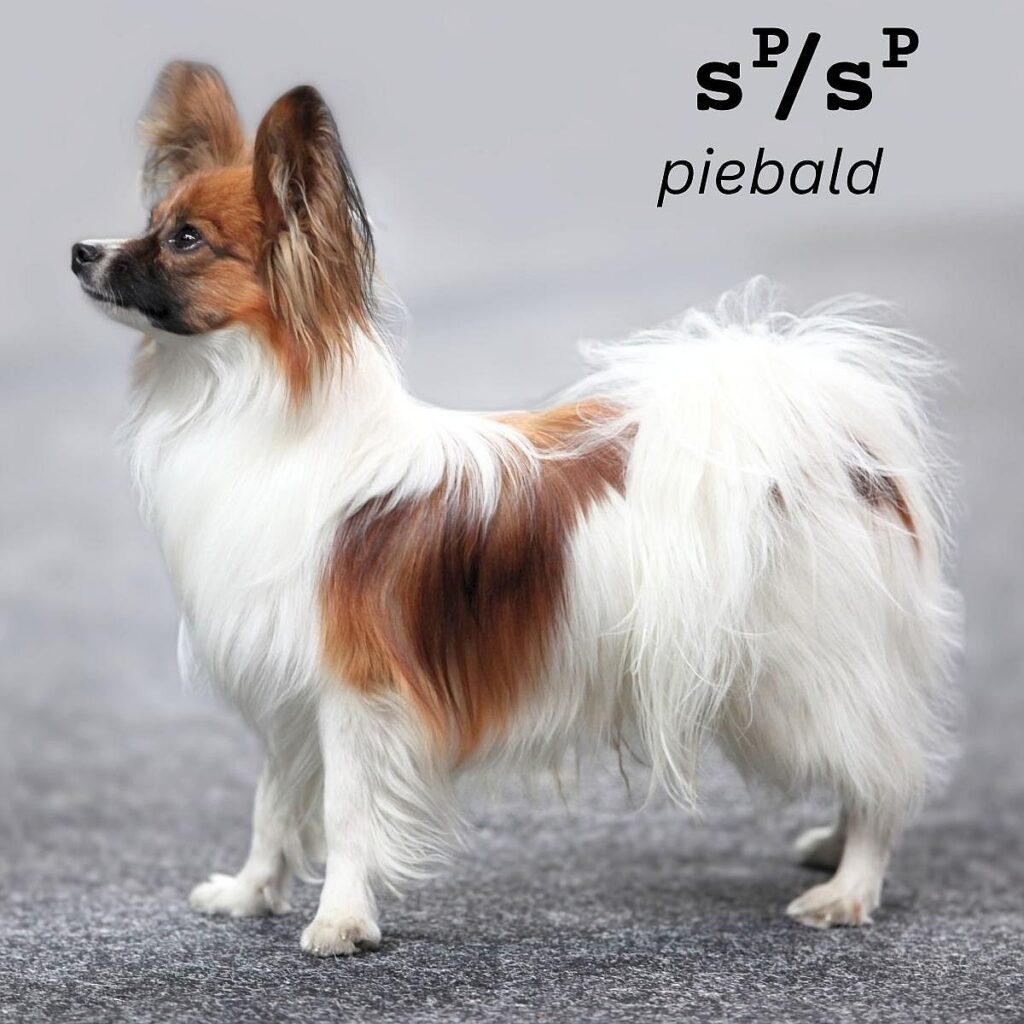

White spotting does have a dose-dependent effect.
- A dog with at least one copy of sP (S/sp) may have minimal to moderate white spotting.
- A dog with two copies of sP (sp/sp) may have moderate to extensive white spotting.
But these predictions don’t always match reality. For example, piebald testing is inconclusive for many Northern breeds. There are unknown modifiers that determine the actual amount of white on a dog.
For now, it helps to interpret piebald testing results depending on the breed.
For example, some breeds with sp/sp produce an intermediate spotting patterns (e.g. Beagles, Bassets), while others produce a predominantly white coat (e.g. Boxers, ACD, English Setter, Bullterrier, etc.).
Remember that there are also several untestable traits such as whitehead or Irish markings that can cause white spotting on their own or add more white to a piebald pattern.
Panda Locus: White Spotting in German Shepherds
A mutation in the KIT gene exclusive to German Shepherd Dogs is called Panda.
Panda is testable and causes a white spotting pattern.
Panda (P) is an autosomal dominant trait with a dose-dependent effect.
- Panda is early embryonic lethal in dogs with two copies (P/P).
- To express the Panda pattern, a GSD has to be heterozygous (P/p).
- Dogs that are homozygous for the wild type (p/p) don’t have Panda spotting.
T Locus: Ticking & Roan
The T locus determines if a dog has a ticking or roan pattern.
Both patterns are only expressed in dogs with white spotting.
Ticking causes pigmented mottles to grow inside white areas.
Roan causes pigmented hairs to grow inside white areas.
Dalmatian flecking seems to be a modified version of roan with large round dots on white. The theorized modifier gene is sometimes called the F locus.
The colors added by these traits follow the pattern a dog has underneath his white spotting.
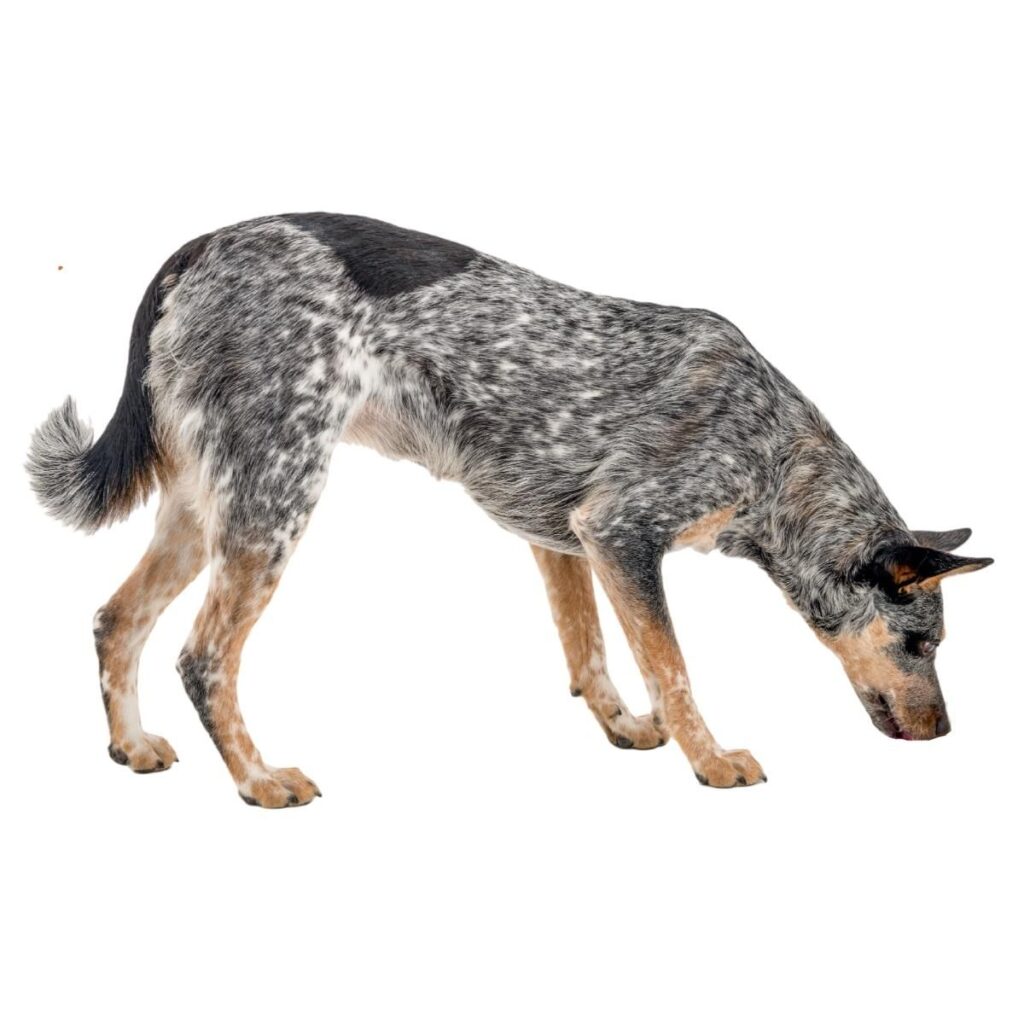
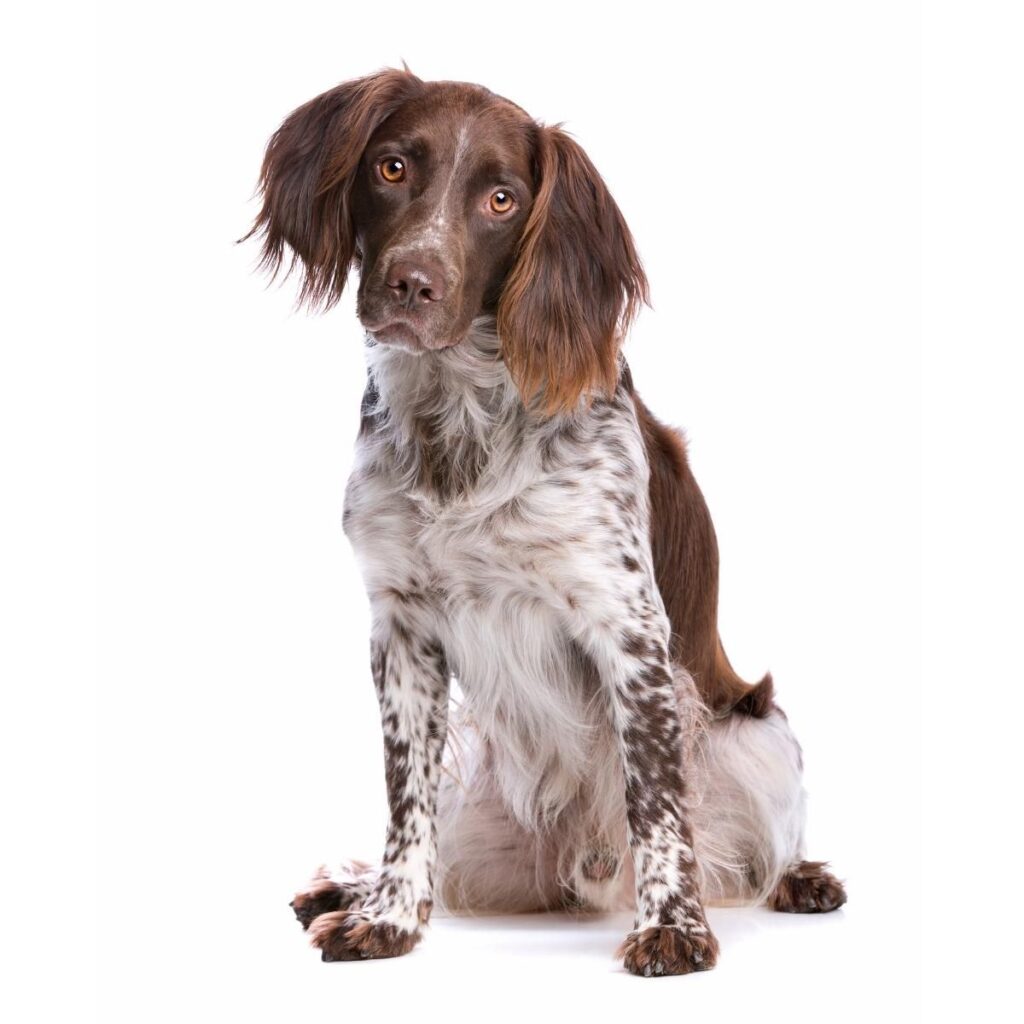
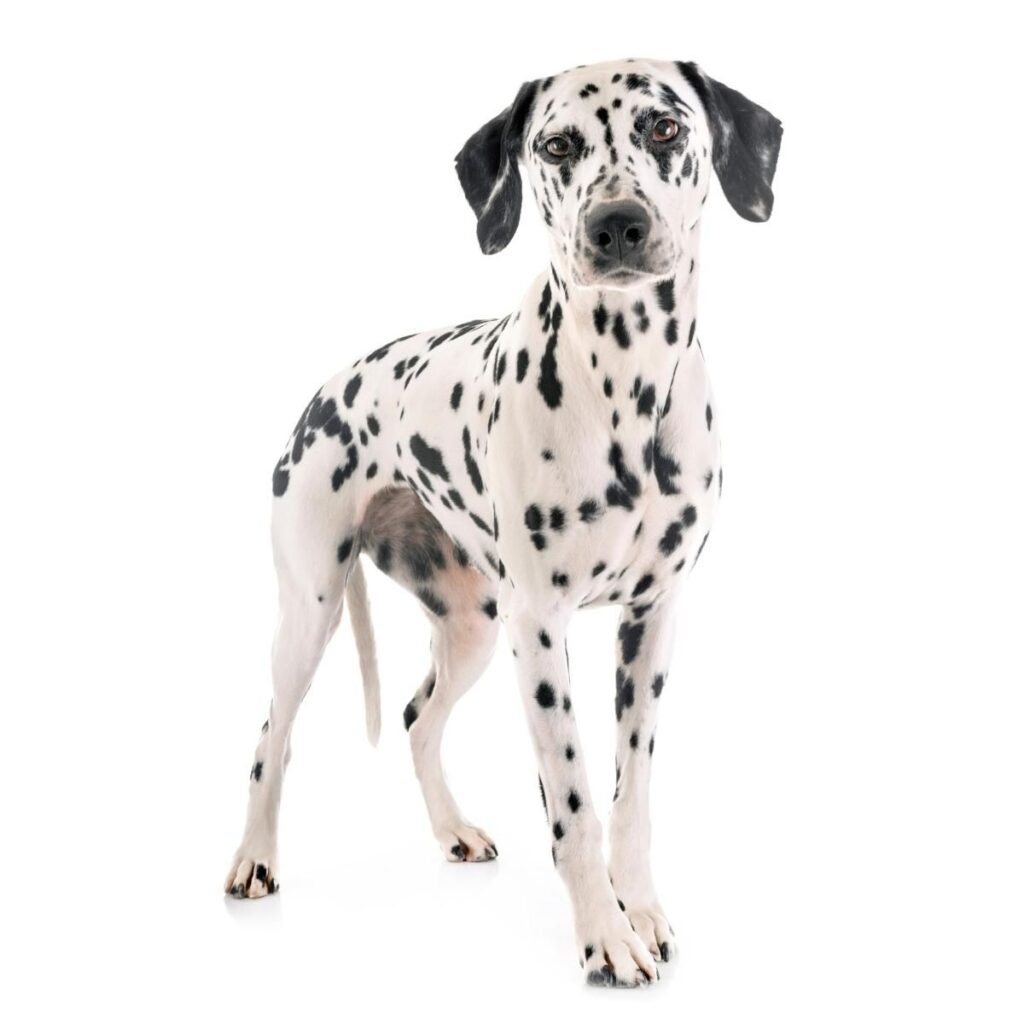
Ticking and roan seem to have a dose-dependent effect with TR causing roan and T causing ticking.
But it is not fully understood in detail how ticking, roan or flecking actually work.
- Dogs with at least one copy of TR may be roan.
- Dogs with at least one copy of T may be mottled.
- Dogs with t/t have clear white markings without ticking or roan.
Links
[1] Online Mendelian Inheritance in Animals.
The Online Mendelian Inheritance in Animals (OMIA) provides a catalogue of traits, associated genes and variants in dogs and more than 400 other species.

Hi! I’m Steffi. I am a biologist and a big time dog nerd. You are curious about coat color genetics? You’ve come to the right place! Read more.

